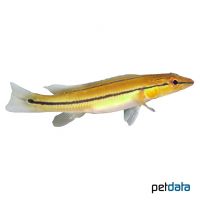Atabapo Crenicichla (Crenicichla sp. 'Atabapo')
| Atabapo Crenicichla Crenicichla sp. 'Atabapo' | |
|---|---|
| Name | Atabapo Crenicichla |
| Name Lat. | Crenicichla sp. 'Atabapo' |
| Family | Cichlids |
| Family lat. | Cichlidae |
| Order | Cichlids |
| Order lat. | Cichliformes |
| Origin | Colombia, Venezuela |
| Habitat | Rivers |
| Diet | Carnivore |
| pH | 5.5-6.5 |
| Behavior | Predatory, aggressive |
| Keeping | Individual, pair |
| Care Level | Moderate |
| Reproduction | Cave spawner |
| Breeding | None reported |
| Life Span | 8-10 years |
| Protection | No |
| Metric Units | |
| Size | 30-40 cm |
| Temperature | 26-28 °C |
| Hardness | 2-10 °dH |
| Aquarium | ~ 500 l |
| US Units | |
| Size | 12"-16" |
| Temperature | 79-82 °F |
| Hardness | 36-178 ppm |
| Aquarium | ~ 130 gal |
Distribution and habitat
The Atabapo Pike Cichlid is native to the Río Atabapo, a blackwater river in the border region of Venezuela and Colombia. There they live in the slow flowing sections of the river with dense riparian vegetation among dead wood and roots.
Maintenance
The aquarium should have a robust border planting, with caves, stones and roots, which provide shelters and hiding places and sufficient free swimming space. A deep substrate of sand or fine gravel, suitable for digging, covered with some foliage (e.g. sea almond tree, beech), some shaded light (floating plants) and a weak current is ideal.
No ammonia, ammonium and nitrite should be detectable, the nitrate value should not exceed 100 mg/l. To ensure the water quality and oxygen content, a filter and heater adapted to the aquarium size is required, as well as lighting for the species-appropriate day-night rhythm of the animals.
Diet
They are lurking hunters. The food supply consists of live and frozen food. For a balanced diet, according to their size, feed once a day with Tubifex, mosquito larvae, krill, shrimp, earthworms, crab and fish meat, etc. (live or frozen). Dry food (pellets, granules, etc.) is rarely accepted.
Only feed as much as will be eaten within a few minutes. Regular and varied feeding promotes health and increases resistance.
Behaviour and compatibility
They are intraspecific and also incompatible with other fish. Especially at spawning time, the territory is fiercely defended. They should be kept singly or in pairs. Juveniles can also be kept in a group. Keeping several pairs is only recommended in a larger and richly structured tank. Socialization is only possible with larger and robust fish, too small fish are considered prey.
Basically, only compatible fish species with similar demands on water quality and water temperature may be socialized.
Sex dimorphism
The sexes are difficult to distinguish. The slightly larger males have a black fringed dorsal fin, the females are more intensely colored.
Reproduction and breeding
Breeding in the aquarium is said to have succeeded occasionally. It is assumed that they are cave breeders and both parents care for the young fish.
Important
Juveniles and adults differ in markings and coloration.
The Atabapo and its tributaries have a particularly soft, reddish-brown water rich in humic substances. The foliage (sea almond tree, beech, etc.) enriches the water with humic substances and naturally lowers the pH.
The well-being of the fish should be checked regularly. The temperature should be checked daily, the pH, hardness and nitrate value at least every 14 days. Regular partial water changes are recommended, even if the contaminant level has not yet reached the upper limit. Sudden changes in water quality should be avoided. Newly introduced fish must be accustomed slowly to the water in the aquarium.
Further literature can be found in your pet store.
References
Text: petdata; Image: petdata
Source: BMELV (1998): Tierschutzgutachten - Haltung von Zierfischen (Süßwasser); ENGELMANN (2005): Zootierhaltung - Tiere in menschlicher Obhut: Fische, Verlag Harri Deutsch; BAENSCH & RIEHL (1997): Aquarien Atlas Bd. 5, Mergus Verlag
- Gemäß § 21 Abs. 5 Tierschutzgesetz idgF
